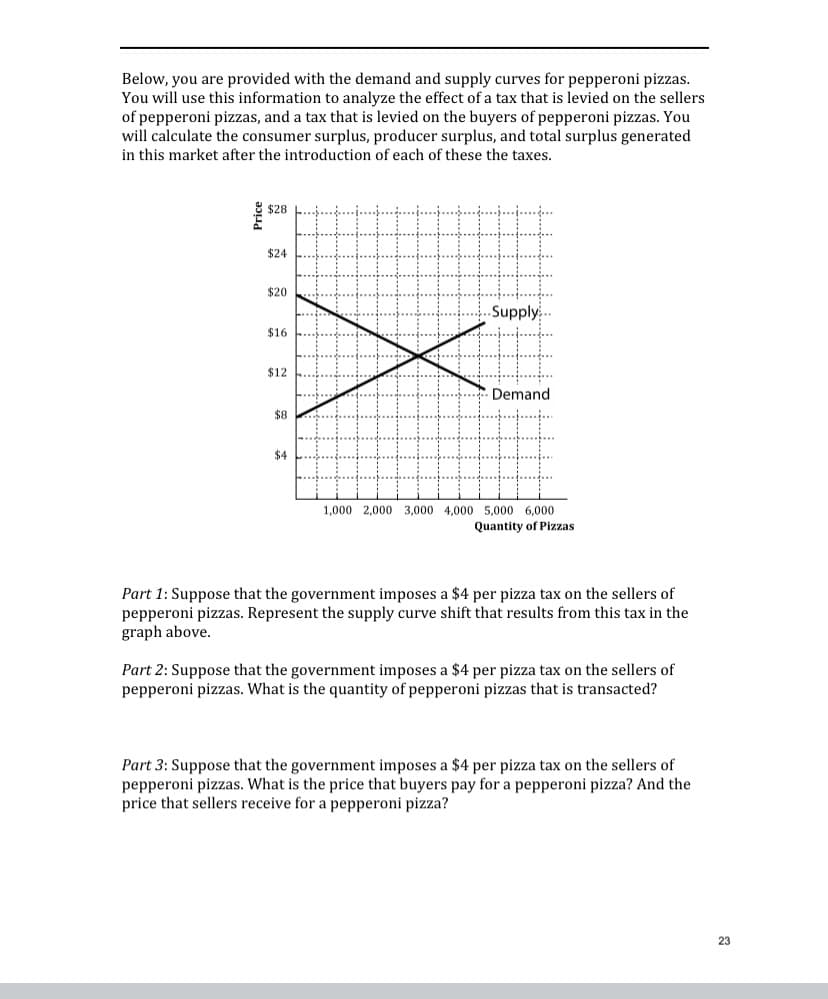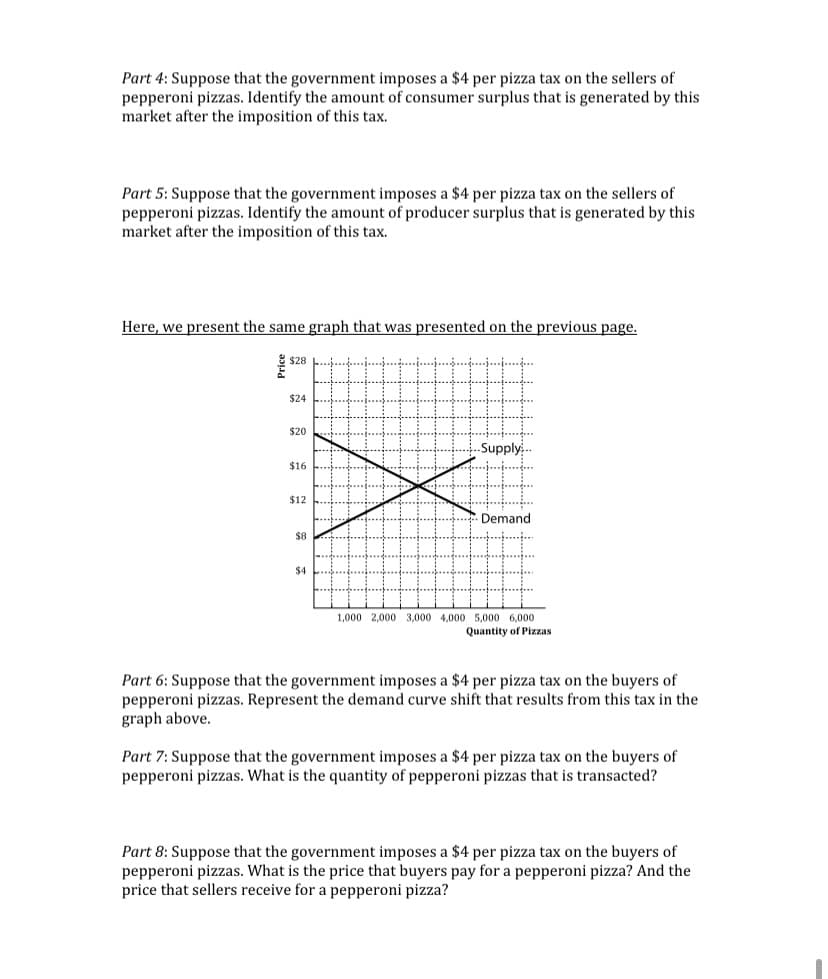Part 1: Suppose that the government imposes a $4 per pizza tax on the sellers of pepperoni pizzas. Represent the supply curve shift that results from this tax in the graph above. Part 2: Suppose that the government imposes a $4 per pizza tax on the sellers of pepperoni pizzas. What is the quantity of pepperoni pizzas that is transacted? Part 3: Suppose that the government imposes a $4 per pizza tax on the sellers of pepperoni pizzas. What is the price that buyers pay for a pepperoni pizza? And the price that sellers receive for a pepperoni pizza?
Part 1: Suppose that the government imposes a $4 per pizza tax on the sellers of pepperoni pizzas. Represent the supply curve shift that results from this tax in the graph above. Part 2: Suppose that the government imposes a $4 per pizza tax on the sellers of pepperoni pizzas. What is the quantity of pepperoni pizzas that is transacted? Part 3: Suppose that the government imposes a $4 per pizza tax on the sellers of pepperoni pizzas. What is the price that buyers pay for a pepperoni pizza? And the price that sellers receive for a pepperoni pizza?
Principles of Economics (MindTap Course List)
8th Edition
ISBN:9781305585126
Author:N. Gregory Mankiw
Publisher:N. Gregory Mankiw
Chapter7: Consumers, Producers, And The Efficiency Of Markets
Section: Chapter Questions
Problem 6PA
Related questions
Question
Tax equivalency worksheet

Transcribed Image Text:Below, you are provided with the demand and supply curves for pepperoni pizzas.
You will use this information to analyze the effect of a tax that is levied on the sellers
of pepperoni pizzas, and a tax that is levied on the buyers of pepperoni pizzas. You
will calculate the consumer surplus, producer surplus, and total surplus generated
in this market after the introduction of each of these the taxes.
& $28
$24
$20
Supply.
$16
$12
Demand
$8
$4
1,000 2,000 3,000 4,000 5,000 6,000
Quantity of Pizzas
Part 1: Suppose that the government imposes a $4 per pizza tax on the sellers of
pepperoni pizzas. Represent the supply curve shift that results from this tax in the
graph above.
Part 2: Suppose that the government imposes a $4 per pizza tax on the sellers of
pepperoni pizzas. What is the quantity of pepperoni pizzas that is transacted?
Part 3: Suppose that the government imposes a $4 per pizza tax on the sellers of
pepperoni pizzas. What is the price that buyers pay for a pepperoni pizza? And the
price that sellers receive for a pepperoni pizza?
23
Price

Transcribed Image Text:Part 4: Suppose that the government imposes a $4 per pizza tax on the sellers of
pepperoni pizzas. Identify the amount of consumer surplus that is generated by this
market after the imposition of this tax.
Part 5: Suppose that the government imposes a $4 per pizza tax on the sellers of
pepperoni pizzas. Identify the amount of producer surplus that is generated by this
market after the imposition of this tax.
Here, we present the same graph that was presented on the previous page.
* $28 ..j...
$24
$20
.Supply
$16
$12
Demand
$8
$4
1,000 2,000 3,000 4,000 5,000 6,000
Quantity of Pizzas
Part 6: Suppose that the government imposes a $4 per pizza tax on the buyers of
pepperoni pizzas. Represent the demand curve shift that results from this tax in the
graph above.
Part 7: Suppose that the government imposes a $4 per pizza tax on the buyers of
pepperoni pizzas. What is the quantity of pepperoni pizzas that is transacted?
Part 8: Suppose that the government imposes a $4 per pizza tax on the buyers of
pepperoni pizzas. What is the price that buyers pay for a pepperoni pizza? And the
price that sellers receive for a pepperoni pizza?
Expert Solution
This question has been solved!
Explore an expertly crafted, step-by-step solution for a thorough understanding of key concepts.
This is a popular solution!
Trending now
This is a popular solution!
Step by step
Solved in 2 steps with 1 images

Knowledge Booster
Learn more about
Need a deep-dive on the concept behind this application? Look no further. Learn more about this topic, economics and related others by exploring similar questions and additional content below.Recommended textbooks for you

Principles of Economics (MindTap Course List)
Economics
ISBN:
9781305585126
Author:
N. Gregory Mankiw
Publisher:
Cengage Learning

Principles of Microeconomics (MindTap Course List)
Economics
ISBN:
9781305971493
Author:
N. Gregory Mankiw
Publisher:
Cengage Learning

Principles of Macroeconomics (MindTap Course List)
Economics
ISBN:
9781285165912
Author:
N. Gregory Mankiw
Publisher:
Cengage Learning

Principles of Economics (MindTap Course List)
Economics
ISBN:
9781305585126
Author:
N. Gregory Mankiw
Publisher:
Cengage Learning

Principles of Microeconomics (MindTap Course List)
Economics
ISBN:
9781305971493
Author:
N. Gregory Mankiw
Publisher:
Cengage Learning

Principles of Macroeconomics (MindTap Course List)
Economics
ISBN:
9781285165912
Author:
N. Gregory Mankiw
Publisher:
Cengage Learning

Essentials of Economics (MindTap Course List)
Economics
ISBN:
9781337091992
Author:
N. Gregory Mankiw
Publisher:
Cengage Learning

Principles of Economics, 7th Edition (MindTap Cou…
Economics
ISBN:
9781285165875
Author:
N. Gregory Mankiw
Publisher:
Cengage Learning

Principles of Macroeconomics (MindTap Course List)
Economics
ISBN:
9781305971509
Author:
N. Gregory Mankiw
Publisher:
Cengage Learning